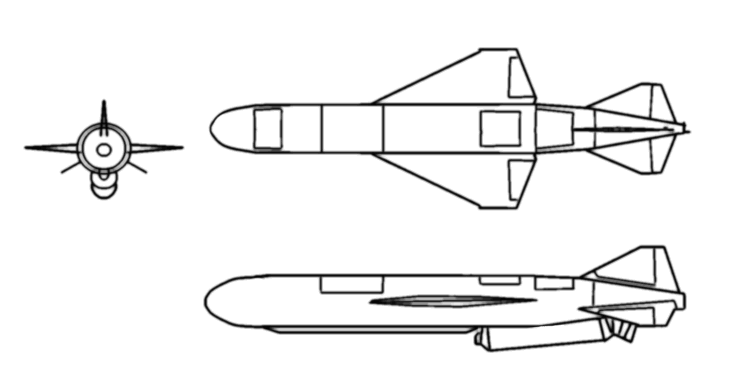
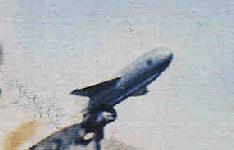

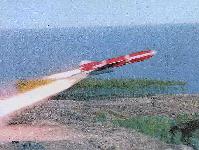
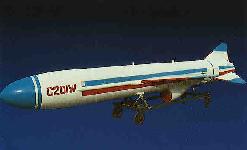
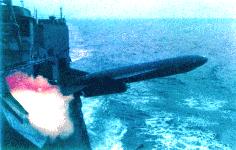
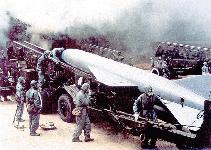
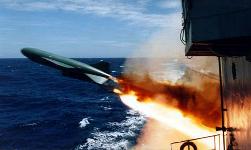
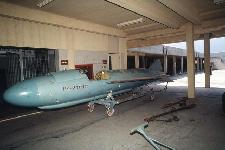
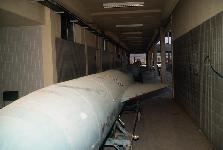
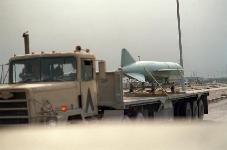
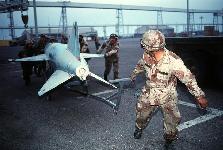
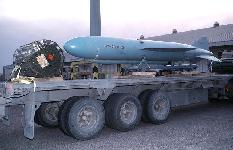
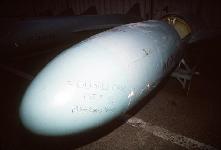
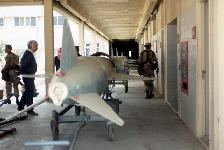




The C-201 is a mid-range ground-, air-, and ship-launched cruise missile developed on the basis of the HY-1, with the primary difference being a longer fuselage accomodating a correspondingly greater propellant capacity. Apart fromt the longer fuselage, the overall configuration of the C-201 missile is similar to the HY-1, with two delta wings and triform rudder and tail. C-201 anti-ship cruise missile variants include the SY-1A [Shang You] for ship launch and the land based HY-2.
The HY-2 [Hongying / Hai Ying] coast-to-ship defensive tactical missile weapon system -- with the Western designation "Seersucker" -- is employed at coastal fortifications, bases or islands to attack enemy surface ships. The system features long range coverage and a large firing sector (+/-85o, enabling one missile battalion to cover a blockaded ocean area of 14,000 square kilometers. After the missile is fired, ground guidance and control are not necessary, and the firing position can remain concealed.
The PLAN has three categories of frigates-Jiangwei-class, Jianghu III- and IV-class, and Jianghu I-class. All of these are armed either with surface-to-surface missiles (SSMs) YJ-1 (Eagle Strike) or Hy-2 (C-201).
The level flight altitude of the missile is low, and the system's anti-jam capabilities are effective against electronic countermeasures. The missile's large warhead can sink or severely damage a 3,000 ton class destroyer.
After 5 years of development the program achieved six hits in seven firings in 1970, when the missile passed final design testing. Based on the combat requirements of Navy forces, a series of modified designs of the HY-2 basic model were developed and produced.The HY-2 missile is also the basis for modified test aircraft and target missiles with various functions.
- HY-2A terminal guidance radar of the prototype missile was modified into a passive infrared target seeker which effectively raised the concealment and anti-jamming capabilities of the missile. The interception performance of this missile within guidance range can realize omnidirectional attacks on ship targets at sea.
- HY-2B the conical scanning terminal guidance radar of the prototype missile was modified to an advanced monopulse system radar which improved its resistance sea waves interference and various forms of electronic jamming.
- HY-2C terminal guidance radar of the prototype missile was modified into a television-equipped target seeker which was able to effectively raise the concealment and anti-jamming capabilities of the missile as well as increase its hit probability.
- HY-2G uses a high precision radio altimeter so that the level flight altitude of the missile can be lowered to 30-50 meters, raising penetration capabilities.
During the Iran-Iraq War, one of China's most controversial arms transfers involved the HY-2 antiship missile, commonly [and improperly] referred to in the media as the "Silkworm." The first of several HY-2 shipments was delivered in the summer of 1986, and in October 1987 an American-owned tanker under the Liberian flag and a Kuwaiti tanker under the US flag, the Sea Isle City, were hit by Iranian HY-2 missiles. China respomded to American complaints by claiming that the weapons had been supplied by North Korea. Although in March 1988 China stated that it would not sell antiship cruise missiles to Iran, HY-2 transfers reportedly continued through 1989. In early 1988 Iran claimed the capacity to manufacture HY-2s and other antiship cruise missiles indigenously. It is currently estimated that Iran has about 100 HY-2 missiles on eight to ten mobile missile launchers deployed on the north side of the Straits of Hormuz.
Specifications
Contractor CHETA - China Hai Yang [Sea Eagle] Electro-Mechanical Technology - CASC 3rd Academy Entered Service Total length 7.36 m Diameter 0.76 m Wingspan 2.4 m Weight 2988 kg Warhead Weight Propulsion one liquid rocket engine and one solid rocket booster Maximum Speed Maximum effective range 95-100km Guidance mode autocontrol + homing Single-shot hit probability > 70%















http://www.fas.org/man/dod-101/sys/missile/row/c-201.htm
Created by John Pike
Maintained by Webmaster
Updated Tuesday, August 10, 1999 6:31:55 PM
| First Page | Prev Page | Next
Page | Back to Text |